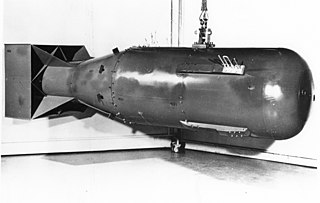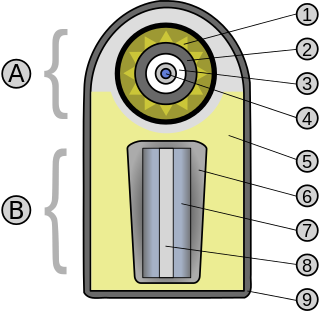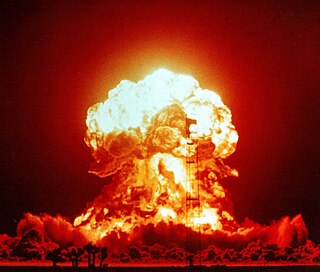Related Research Articles

The Tsar Bomba, also known by the alphanumerical designation "AN602", was a hydrogen aerial bomb, and the most powerful nuclear weapon ever created and tested. Tsar Bomba was developed in the Soviet Union (USSR) by a group of nuclear physicists under the leadership of Igor Kurchatov, an academician of the Academy of Sciences of the Soviet Union.

Nuclear weapons tests are experiments carried out to determine nuclear weapons' effectiveness, yield, and explosive capability. Testing nuclear weapons offers practical information about how the weapons function, how detonations are affected by different conditions, and how personnel, structures, and equipment are affected when subjected to nuclear explosions. However, nuclear testing has often been used as an indicator of scientific and military strength. Many tests have been overtly political in their intention; most nuclear weapons states publicly declared their nuclear status through a nuclear test.

The RDS-1, also known as Izdeliye 501 and First Lightning, was the nuclear bomb used in the Soviet Union's first nuclear weapon test. The United States assigned it the code-name Joe-1, in reference to Joseph Stalin. It was detonated on 29 August 1949 at 7:00 a.m., at the Semipalatinsk Test Site, Kazakh Soviet Socialist Republic, after top-secret research and development as part of the Soviet atomic bomb project.
The Soviet atomic bomb project was the classified research and development program that was authorized by Joseph Stalin in the Soviet Union to develop nuclear weapons during World War II.
Joe 4 was an American nickname for the first Soviet test of a thermonuclear weapon on August 12, 1953, that detonated with a force equivalent to 400 kilotons of TNT. The proper Soviet terminology for the warhead was RDS-6s, Reaktivnyi Dvigatel Specialnyi, lit. 'Special Jet Engine'.
RDS-37 was the Soviet Union's first two-stage hydrogen bomb, first tested on 22 November 1955. The weapon had a nominal yield of approximately 3 megatons. It was scaled down to 1.6 megatons for the live test.

A thermonuclear weapon, fusion weapon or hydrogen bomb is a second-generation nuclear weapon design. Its greater sophistication affords it vastly greater destructive power than first-generation atomic bombs, a more compact size, a lower mass, or a combination of these benefits. Characteristics of nuclear fusion reactions make possible the use of non-fissile depleted uranium as the weapon's main fuel, thus allowing more efficient use of scarce fissile material such as uranium-235 or plutonium-239. The first full-scale thermonuclear test was carried out by the United States in 1952; the concept has since been employed by most of the world's nuclear powers in the design of their weapons.

Mark 7 "Thor" was the first tactical fission bomb adopted by US armed forces. It was also the first weapon to be delivered using the toss method with the help of the low-altitude bombing system (LABS). The weapon was tested in Operation Buster-Jangle. To facilitate external carry by fighter-bomber aircraft, Mark 7 was fitted with retractable stabilizer fins. The Mark 7 warhead (W7) also formed the basis of the 30.5 inches (775 mm) BOAR rocket, the Mark 90 Betty nuclear depth charge, MGR-1 Honest John rocket, and MGM-5 Corporal ballistic missile. It was also supplied for delivery by Royal Air Force Canberra aircraft assigned to NATO in Germany under the command of SACEUR. This was done under the auspices of Project E, an agreement between the United States and the UK on the RAF carriage of US nuclear weapons. In UK use it was designated 1,650 lb. H.E. M.C. The Mark 7 was in service from 1952 to 1967(8) with 1700–1800 having been built.

Project 596, was the first nuclear weapons test conducted by the People's Republic of China, detonated on 16 October 1964, at the Lop Nur test site. It was a uranium-235 implosion fission device made from weapons-grade uranium (U-235) enriched in a gaseous diffusion plant in Lanzhou.

A nuclear explosion is an explosion that occurs as a result of the rapid release of energy from a high-speed nuclear reaction. The driving reaction may be nuclear fission or nuclear fusion or a multi-stage cascading combination of the two, though to date all fusion-based weapons have used a fission device to initiate fusion, and a pure fusion weapon remains a hypothetical device. Nuclear explosions are used in nuclear weapons and nuclear testing.

The Totskoye nuclear exercise was a military exercise undertaken by the Soviet Army to explore defensive and offensive warfare during nuclear war. The exercise, under the code name "Snowball", involved an aerial detonation of a 40 kt RDS-4 nuclear bomb. The stated goal of the operation was military training for breaking through heavily fortified defensive lines of a military opponent using nuclear weapons. An army of 45,000 soldiers marched through the area around the hypocenter soon after the nuclear blast. The exercise was conducted on September 14, 1954, at 9.33 a.m., under the command of Marshal Georgy Zhukov to the north of Totskoye village in Orenburg Oblast, Russia, in the South Ural Military District. The epicenter of the detonation is marked with a memorial.
RDS-4 was a Soviet nuclear bomb that was first tested at Semipalatinsk Test Site, on August 23, 1953. The device weighed approximately 1200 kg. The device was approximately one-third the size of the RDS-3. The bomb was dropped from an IL-28 aircraft at an altitude of 11 km and exploded at 600 m, with a yield of 28 kt.
Yevgeny Ivanovich Zababakhin was a Soviet military engineer, theoretical physicist and one of the chief designers of nuclear weapons in the USSR. Amongst many others, he was involved in the first Soviet nuclear bomb (RDS-1) and the design of the first Soviet two-stage hydrogen bomb (RDS-37).
RDS-3 was the third atomic bomb developed by the Soviet Union in 1951, after the famous RDS-1 and RDS-2. It was called Marya in the military. The bomb had a composite design with a plutonium core inside a uranium shell, providing an explosive power of 41.2 kilotons. The RDS-3T was a modernized version and the first mass-produced nuclear weapon by the Soviet Union. It was assigned to Long Range Aviation in 1953.
The RDS-2 nuclear warhead was created and designed by the Soviet Union during the late 1940s and early 1950s. RDS-2 was first secretly tested on September 24, 1951, at a Soviet test site in Kazakhstan. RDS-2 was a plutonium only device with an estimated yield of 38 kt.
German Arsenyevich Goncharov [Russian: Гончаров Герман Арсеньевич] was a Soviet and Russian nuclear physicist, engineer and mathematician. He was a key member of the theoretical team which developed and tested Soviet thermonuclear weapons from 1952 and he led a theoretical department at the Soviet nuclear research facility at Arzamas-16 from 1967 to 2004.
Vyacheslav Petrovich Feodoritov (February 28, 1928 - January 2, 2004) was a Russian nuclear physicist, engineer and mathematician. He was a co-designer of the first two-stage Soviet thermonuclear device, the RDS-37, and became a chief of laboratory at Arzamas-16, now known as the All-Russian Scientific Research Institute of Experimental Physics.
References
- ↑ Bukharin, Oleg; Kadyshev, Timur; Miaskinov, Eugene; Sutyagin, Igor; Tarasenko, Maxim; Zhelezov, Boris (2001). Podvig, Pavel (ed.). Russian Strategic Nuclear Forces. Cambridge, Massachusetts: The MIT Press. ISBN 978-0262162029.